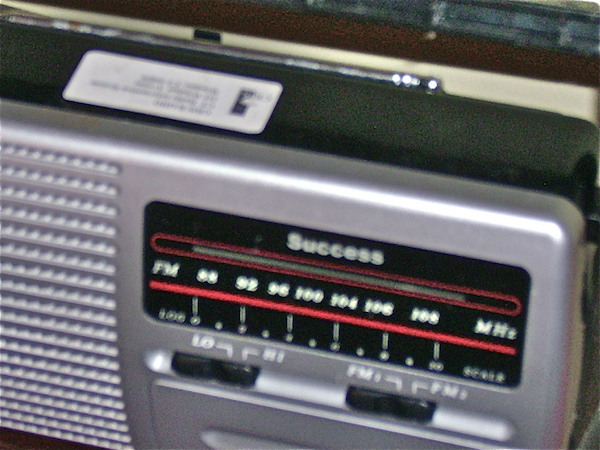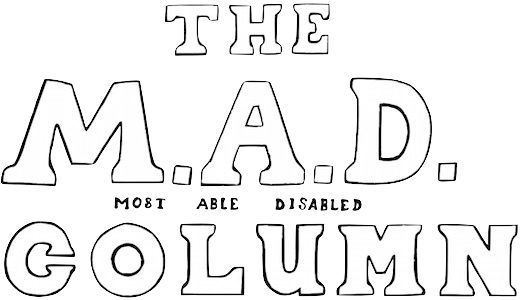
Radio for the blind
photo by Daniel Ortoleva
80's Handicapped Tech
Blind Blue Box
Handicapped people indirectly helped inspire the first personal computers. Several blind men figured out how the telephone company switched calls. Joe Engessia Jr. realized that a toy whistle in a cereal box produced the musical note E one octave above middle C allowing a user to make free phone calls. A sighted hacker, John Draper, called himself "Captain Crunch" after this toy whistle and made an illegal telephone dialing device called a blue box that produced the correct tones.
Reading a 1972 article about blue boxes motivated Steve Wozniak to contact Draper who helped him build his own and also taught him how not to get caught. As a demonstration of "phone Phreaking"they called the Pope with Woz faking a Henry Kissinger accent. Captain Crunch called President Nixon about being out of toilet paper. These "white hat" hackers were just curious to explore and learn about telephone equipment and anonymously reported bad phone lines they discovered to phone company employees. Blue boxes no longer work on phone systems no longer using audio tones as a cost saving measure.
The first word processor program for Apple Computers was written by John Draper in 1979. He used the Apple modem to make more than 30 thousand calls in 1 month. Ironically, Draper, the man who got started from a tip by a couple of handicapped men now uses a wheelchair. Steve Wozniak credits his experimentation in designing the electronics for his blue box with him and Steve Jobs to later develop the Apple computer.
Meg's 1984 columns were at the same time that Apple revealed a speaking computer that included fonts that were easier to read for those with vision problems. Computer speaking voices in the 1980's had a very unnatural robotic sound and before then computer screens had green typewriter styled text on a black background.
Today, dictating a message is built into many computers and phones. This feature helped transcribe Meg's almost 125 columns. Spellcheck ironically got Meg's disease progeria correct but often missed common words like wheelchair. Another area for improvement is the dictation software changed affirmative words from Meg's positive attitude such as can into can't.
A blind man working at a local radio station left when they changed their computers to PCs that didn't have the accessibility features he needed to perform his duties found in the Apple computers he was used to. Not being distracted by the special effects, he focuses on the acting in his new career reviewing movies.
Handicapped Cash Register
April 27 1983
Here's a piece of good news to many visually impaired people.
The Grand Union, On Barnum Ave., Stratford, is now using a checkout system that talks to you,. (No, I'm not talking about new, amiable cashiers.)
It seems that with age of computers has come a wonderful "gizmo" that tells aloud the names of the products and prices as each one is rung up. This will be a great aid, I should think, in building confidence in many shoppers who might have trouble doing these things by themselves.
I'm just delighted to see steps being taken to acknowledge the desirability of disabled consumers patronage. Is about time someone realized that our money is green too.
The price reading cash registers didn't catch on, one possible explanation is the employees may have found it distracting if the voice was always on. These days, Meg would probably love the automatic door buttons and the accessibility features on computer such as dictating text and voice commands which assisted in transcribing these articles.
A blind man was very popular reporting the local traffic conditions left one radio station when they switched their computers to PCs instead of the Apple computer that supported the features he needed to perform his duties. He focuses on the acting and scriptwriting in his new career of movie reviewer by not being distracted by the special effects.
Disabled Telephone Directory Assistance
May 16 1984
Dear Readers,
I have been sent the following letter by Southern New England Telephone Company, asking me to pass on some news about a newly proposed billing system which will save "certain disabled persons" money off of their monthly phone bills:
Dear Customers,
AT&T has asked the FCC for approval of a proposed plan allowing certain disabled persons to be exempt from the charge if they place calls to the interstate Directory Assistance.
When the IDA Plan goes into effect, 50 calls per month can be made to out-of-state Directory Assistance from your telephone, at no charge.
If you believe that you or a member of your household may be eligible for this exemption, please complete the application form, and return the completed form to SNET.
Readers,
It is really very encouraging to see large concerns as SNET Co. recognizing the specialized needs of the individual disabled customer and making great efforts to provide the assistance services and make available the latest adoptive equipment to the public for the quickest safest and most appropriate service possible today!
TDD At Fire Dept.
March 21 1984
Dear Readers,
The fire department has now completed the addition of a new TDD number to the regular emergency rescue system of 911!
A TDD is otherwise known as telecommunications device for the deaf – hence the initials. These numbers are hooked up to communication devices that can both receive and transmit typed messages between people with similar machines who are unable to make themselves understood.
A teletype machine is the bully forerunner to the lightweight TDD model.
A TDD is no bigger than a desktop calculator and could easily be mistaken for one at first glance. The difference is that a small typewriter keyboard replaces the adding machine numbers and an amplified holder for your telephone receiver is situated on the top where the roll of adding machine tape might be.
TDD messages run across the small screen to print similar in fashion to the way special news bulletins race along the bottom of your television picture. The old teletypes left you with reams of printed readout sheets to contend with, not to mention the amount of space the machine itself took up in comparison. (Technology comes through for the guy, yeah!)
Anyone not yet owning a TDD machine but would like to is asked to call Milford Fire Department or the M.I.D.P. Office for further information.
Anyone already owning one is asked to contact the Milford Fire Department and an M.I.D.P. so that you can be set up into this system and the business of protecting everyone's future against special emergencies requiring firemen, police, or ambulance can begin.
Each person will be given his or her own emergency number when registering with the E.O.C. to be used when calling the E.O.C. the first thing. A card gets filled out with your name, address, phone number, the number of people in your household and any other important information such as wheelchair use, special medications needed or a chronic health problems. All of these cards will be kept strictly confidential.
It is being set up for your safety and protection. Any help in reaching and or identifying persons appropriate for such service will be greatly appreciated by the whole community. Milford has taken another progressive step forward!
TDD are increasingly becoming legacy devices with email for sending text now being but that requires an internet connection or data plan on a cellphone.
Newspaper For The Blind
July 11 1984
Dear Readers,
The latest information and services for the visually impaired is a radio service called CRIS - The Connecticut Radio Information Service.
CRIS is a private, non-stock, non-profit Connecticut corporation which was organized for the purpose of making the same immediacy of access to printed material available to the general population available to the blind or print-handicapped individuals - by radio.
Like several dozen other such radio reading services now operating on FM sidebands in other parts of the country, CRIS focuses a great amount of its programming on simply reading the newspapers. They read not only the front page news articles in full, but continue through to the back of the paper. The personality and background features, commentaries, editorials, Dear Abby's, Horoscopes, Supermarket ads, and even the comics!
Also, CRIS airs other current readings not readily available to the print-handicapped, and will supply other programming of particular interest to their audience which is disabled, such as, disseminating information to the print-handicapped community about job opportunities of particular interest to someone with a disability.
For a modest annual subscription fee, CRIS will furnish the special radio receiver needed to listen to CRIS. The radio receiver comes to you on a loan basis and can be kept for as long as you are a subscriber.
It's rather fun to picture my visually impaired friends enjoying the daily newspaper with their morning coffee! And they will be able to use two free hands to jelly their toast … Maybe we should all subscribe and drop out of Slobs Anonymous once and for all. Think of the cleaning bills we'd cut down on!
CRIS donation request letter (in large 18 or 25 pt Helvetica type)
Dec. 7, 2015
A 2015 donation letter (printed in large type) for CRIS included: CRIS Radio offer a variety of programs to meet the needs and interests of our listeners. Some listen for world and national news from USA Today, The Wall Street Journal, The New York Times, and the Christian Science Monitor; some for state and local news from Connecticut's newspapers; others tune into hear the editorial pages, sports news, grocery and department store circulars, or the advice columns.
All of these programs are made possible by a very dedicated group of volunteers who share their time and skills who share their time and skills to read the articles, operate the studio equipment, pack and ship radios, and serve on the Board of Directors.
CRIS is now available online at www.crisradio.org but the player is Flash based which limits being heard on mobile devices. Apple computers stopped supporting Flash in 2011 due to the security issues that Steve Jobs outlined on April 29, 2010. No phone or tablet manufacturer has been able to run the Flash problem free.
Theaters And Hearing Aids
March 6 1985
Hello Readers,
Each of us I was at one time or another experienced the frustration of sitting in the back of an audience and not being able to hear the sounds of the speakers on stage – or – to be unable to clearly distinguish the words of a conversation from surrounding chatter, even should he or she shout about every word with perfect enunciation right in your face. You still can't hear well enough to get the message! It is rather like listening to a radio that is on the fritz. It works enough to make sounds that will drive you away! Imagine suffering with that inconvenience all the time?
Well, the truth is that everyone will go through a bit of loss of hearing loss to some degree. Some more severely than others but with so much of the population being familiar with the trauma of deafness, if only by association. There are constant technological improvements made to increase the degree of participation to the sounds which we cannot hear through amplification.
Simple things, which most of us take for granted, like voices, speech, music, communications, and sound.
They are lost, in part, if not in whole, to the person, with hearing difficulty, even with the the use of a hearing aid.
Out of this hopelessness, and accompanying embarrassment, many hearing-impaired persons do not attend churches, synagogues, theaters, meetings, and other public places. This problem diminishes not only their enjoyment of life but their ability to function as well.
One answer for the hearing impaired individual's ability to enjoy the entertainment of a public performance to the fullest is Induction Lamp Amplification. ILA remove background noises and faulty acoustics that distort sounds.
Most of these people can now actually enjoy and participate in activities that they currently avoid.
Very simply, an ILA system contains a microphone, an amplifier and a antenna wire on the floor or wall around the audience. A harmless magnetic field is created within the area, allowing a hearing aid user to hear only the otherwise inaudible sound emanating from the ILA system. Merely by the flick of the telephone (T) switch on the hearing aid, the user can greatly enhance his or her ability to understand the speaker.
Because of that invisible "indirect connections" between the speaker and that listener's hearing aid, there is no interference from room acoustics or background noise. Even more so, ILA effectively eliminates the distance between the sound source and the listener.
Hence ILA removes the need for a front-row lip reading or special seating for amplification. The hearing impaired listener can blend into the audience without making his or her disability known.
Not only is the understanding of the spoken word improved with ILA, but also musical enjoyment is enhanced.
In Europe, the use of ILA is widespread, even required by law for certain public places in the the country. However, in the U.S. many people are totally unaware of its existence and useful application.
Public Meeting Rooms
February 13 1985
The town of Wethersfield was the National Office on Disabilities (N.O.D.) grand prize winner in 1983 for being architecturally accessible!
Wethersfield's improvements to enhance and safeguard the rights of all the community included installing a complete auditory system in early 1985 into their public meeting rooms for the hearing impaired.
Still in use in 2015, ILA can really mess with electric guitars because the induction loop adds so much noise that is was unusable. Many venues will ignore the law and shut off the induction loop if it is interfering too much with the show.
- Ritchie Blackmore's monitor soundman Barry Bromstön on European use.
Wheelchair Storage
March 27 1985
Dear Meg,
Although the beast is expensive, someone might be interested in this news article reads from the February 1985 issue of Auto Week.
Handicapped who find a motoring a nuisance because of having to stow their wheelchair in the car before a trip might enjoyed the latest convenience available to them is an integral wheelchair hoist and storage for manual folding chairs. This device resembles an articulated roof rack incorporating a motor driven hook and cable.
The 12 volt motor can raise and store a folding wheelchair in about 45 seconds, and remove and lower in 25 seconds.
This unit offers handicapped freedom from asking companions or passerbys to help them store or retrieve their wheelchair from the rear seat or trunk. It should not cause clearance problems with most residential and commercial garages.
Bob
Dear Bob:
I am always interested in learning about the latest gadgets and gizmos on the market today especially in the line of an adaptive aid to help overcome some physical limitation, despite the seemingly high costs. Compared to the extremely expensive prices of new or second hand vans adapted with lifts and any other required mechanisms for the individual needs of the disabled driver, all suggestions - wild or not - will gratefully be taken under consideration.
Adaptive equipment for motor vehicles is ridiculously expensive. The special equipment installed can cost more than the price of a new car itself, in most cases! Unfortunately, the disabled consumer is over the proverbial barrel at this point in time. A new market is only now opening up on the present day supplier is gradually waking up to the potential growth of this type of business.
There are 10 million disabled people in the U.S. alone! Hopefully, the bold and inventive entrepreneurs out there will also read this column and go out and drive down those sky-rocketing high prices by giving today's "adaptive specialists" some stiff competition in their field! I'd like to be able to afford my "own dream car." now, someday … Soon!
UNIT STILL AVAILABLE
Handicapped Demo
February 16 1983
There is going to be an Adaptive Equipment and Home Care Equipment Demonstration set up in the Connecticut Post Mall, February 16 1983 through Saturday, February 19. All the latest!



